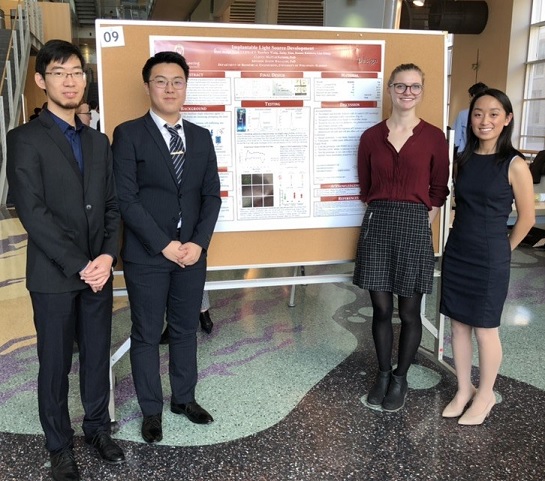Implantable light source for optogenic alteration of immune response
Project Overview
Optogenic activation or blocking of neurons is well established and now we use that approach to alter immune cell functions in mice to understand inflammatory responses in brain (Dr. Fabry)and lung diseases (Dr. Sandor) We have the mice that express light sensitive ionchannels in dendritic cells (an initiator of immunity) and in vitro we have showed they alter Ca uptake of these cells.
In vivo light delivery is key to that project. We need a solution for 470nm and possible 405 nm light that can deliver light to a larger are (about 1cm diagonal) and can be switched on -off for hours in the animal. That approach will study immunity in an animal model of multiple sclerosis (Dr. Fabry) and tuberculosis Dr. Sandor.
Last year the team successfully photoconverted mouse cells with their prototype. This semester's time will be used to refine the prototype and coat it with biocompatible material so it can be used in vivo.
Team Picture

Files
- Preliminary Presentation (February 7, 2020)
- Final Report (May 1, 2020)
- Project Design Specifications (May 1, 2020)
- Preliminary Report (May 1, 2020)
- Final Notebook (May 1, 2020)
- Final Poster Presentation (April 24, 2020)
Contact Information
Team Members
- Ruochen Wang - Team Leader
- Hanna Rainiero - Communicator
- Jacky Tian - BSAC & BPAG
- Lisa Xiong - BWIG
Advisor and Client
- Prof. Justin Williams - Advisor
- Prof. Matyas Sandor - Client
- Martin Hsu - Alternate Contact
Related Projects
- Spring 2020: Implantable light source for optogenic alteration of immune response
- Fall 2019: Implantable light source for optogenic alteration of immune response
- Fall 2018: Implantable light source for optogenic alteration of immune response
